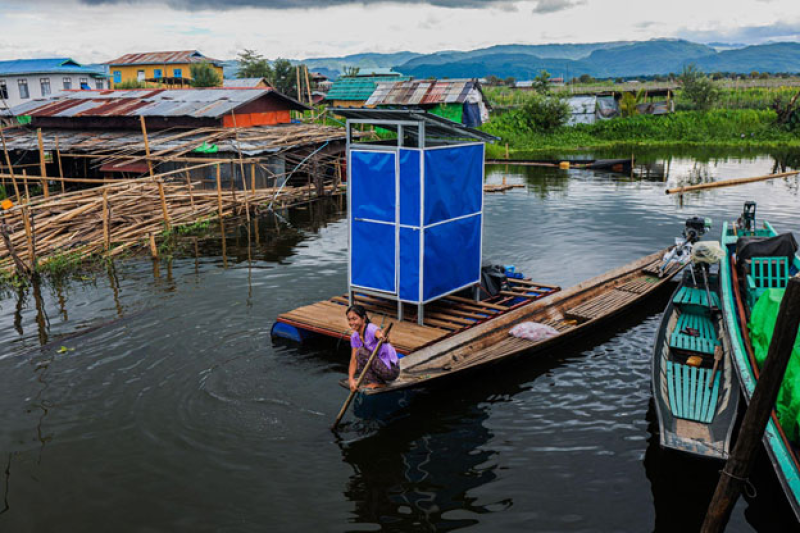- As debate over the location of climate conference razes on, will COP fail this time too? |
- UN Rights Office Warns of Gaza Escalation, West Bank Annexation |
- UN Warns Wildfires and Climate Change Worsen Air Quality |
- OIC Hails Belgian Declaration of Intent to Recognize Palestinian State |
- Bomb blast kills 15 near political rally in Pakistan |
UNICEF, WHO Warn One in Four Lack Clean Drinking Water

A woman pulls a floating toilet into the lake in Kaylar village in Shan State, Myanmar, on June 25, 2025. After the earthquake, the onset of the rainy season made access to safe sanitation challenging for displaced communities.
Over the past decade, major strides have been made in expanding global access to water, sanitation, and hygiene (WASH) services, with billions of people around the world seeing improvements in overall health and well-being. Despite these gains, people—largely from low-income countries and marginalized groups—still lack access to clean water, leaving them vulnerable to disease and hindering social development and inclusion.
On August 26, the World Health Organization (WHO) and the United Nations Children’s Fund (UNICEF) released a joint report, Progress on Household Drinking Water and Sanitation 2000–2024: Special Focus on Inequalities, to commemorate World Water Week 2025 and highlight the persisting gaps in access to WASH services.
Although notable progress has been made since the turn of the century, recent advances toward achieving the 2030 Sustainable Development Goals (SDGs) have stagnated. To establish universal access to WASH services and end open defecation, there must be increased investment in WASH infrastructure, strengthened international cooperation, and community engagement that empowers marginalized communities.
“Water, sanitation, and hygiene are not privileges; they are basic human rights,” said Dr Ruediger Krech, Director of Environment, Climate Change, and Health at WHO. “We must accelerate action, especially for the most marginalized communities, if we are to keep our promise to reach the SDGs.”
The report notes that much of the recent progress has been in rural areas, where access to safe drinking water rose from 50% to 60% over the past decade, and basic hygiene coverage rose from 52% to 71%. However, millions in these areas still lack adequate WASH services, and progress in urban regions has stalled significantly.
It is currently estimated that approximately one in four people globally—or 2.1 billion—lack access to clean drinking water, with 106 million relying on untreated surface water sources such as ponds, lakes, and rivers. UN figures show that inadequate access to WASH services contributes to roughly 3.5 million deaths per year.
The report also reveals that roughly 3.4 billion people lack safely managed sanitation, with 354 million still practicing open defecation. Furthermore, about 1.7 billion lack access to basic hygiene services in their homes, and 611 million lack any hygiene facilities.
People in least-developed countries are approximately twice as likely to lack adequate access to essential WASH services. This gap is most pronounced in regions affected by poverty, conflict, or climate vulnerability, where access to clean drinking water is on average 38% lower than in other areas.
Children are among the most disproportionately impacted by the lack of WASH services, facing heightened risks of disease, malnutrition, stunted growth, and developmental delays. Without safe running water, many children miss school due to waterborne illnesses or time spent collecting water. Long-term impacts include disrupted schooling, reduced employment opportunities, and hindered social development.
“Every year, nearly 400,000 children under five die from diseases attributable to inadequate water, sanitation, and hygiene services,” said Cecilia Scharp, UNICEF Director of WASH. “In low-income and rural communities, children are especially vulnerable to diarrheal diseases, malnutrition, and stunted growth. These conditions threaten survival and hinder cognitive development and long-term potential.”
Women and girls are particularly affected, as they are primarily responsible for water collection, especially in sub-Saharan Africa and Central and Southern Asia. They spend over 30 minutes per day collecting water, a task linked to higher rates of school absenteeism and reduced productivity.
“In sub-Saharan Africa, only 16% of the rural population has water on premises. In countries like Malawi, women and girls are responsible for water collection in 76% of households,” added Scharp. “This daily task exposes them to physical strain, safety risks, and lost time, with long-term systemic consequences.”
Lack of WASH services also increases health risks for women and girls, including menstruation-related infections, waterborne diseases, and sepsis among mothers and newborns. UN Women reports that at least one in ten women and girls in rural areas across 12 countries lacked access to private spaces to wash and change during menstruation.
WHO and UNICEF also highlight the widespread lack of menstrual products and safe facilities, preventing girls from changing as often as needed. Adolescent girls aged 15–19 are less likely than adult women to attend school, work, or participate in social activities during menstruation. “These disparities perpetuate cycles of poverty and limit social and economic development,” said Scharp.
With the world’s population growing and the climate crisis exacerbating water scarcity, accelerated humanitarian action, increased investment, and community-driven approaches that prioritize women and low-income communities are imperative.
UNICEF is working with governments to strengthen WASH systems and expand access for marginalized and underserved communities through climate-resilient infrastructure and early warning systems for extreme weather events. “Our approach focuses on long-term sustainability, equity, and resilience—ensuring that no one is left behind,” said Scharp. “We also support water resource assessments and groundwater monitoring, helping governments develop and sustain early warning systems, and take preventive actions benefiting children and communities.”

